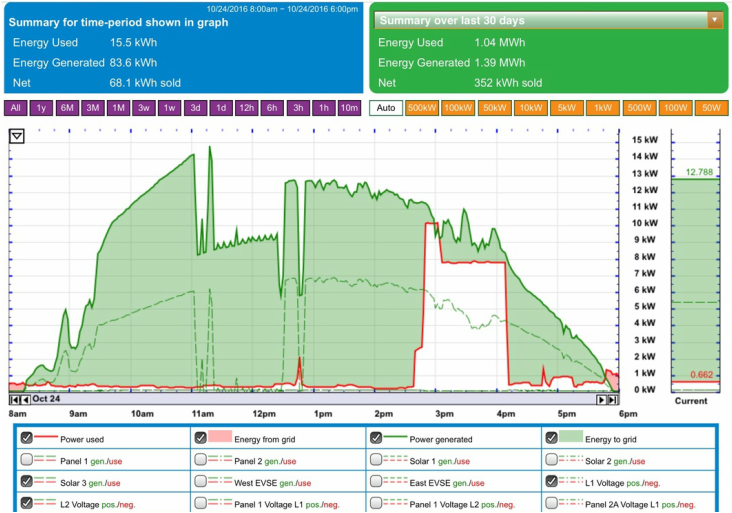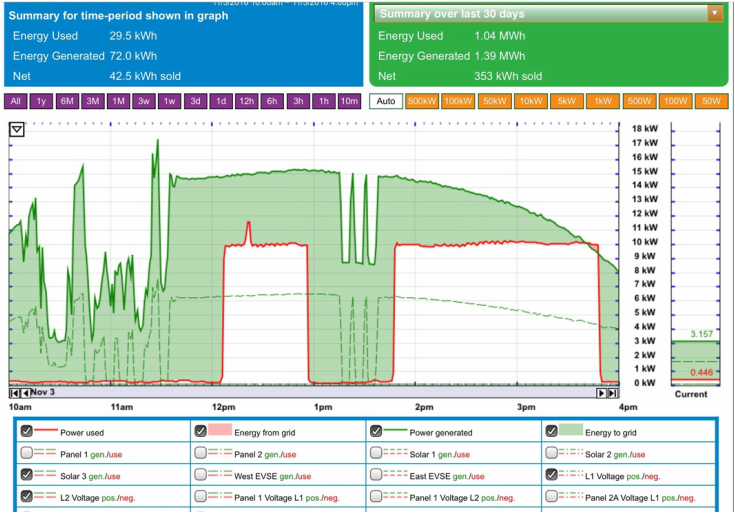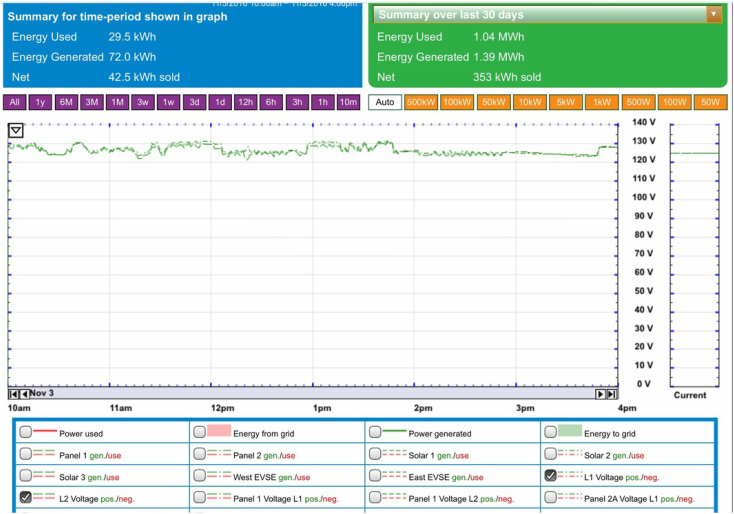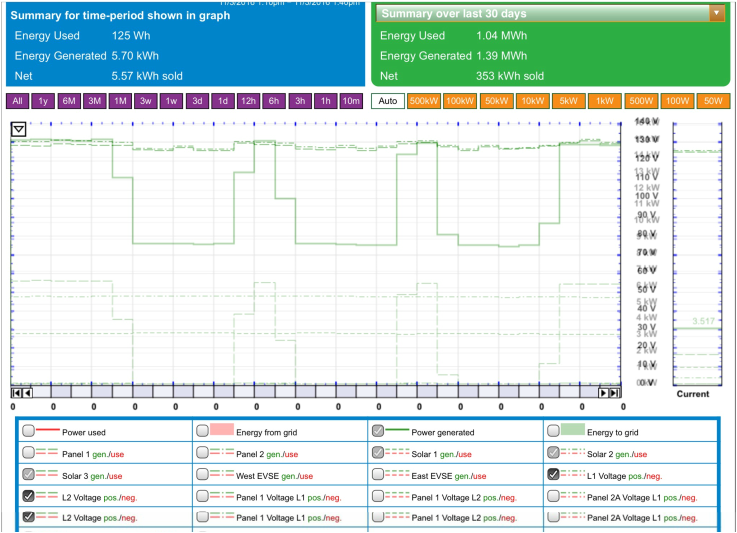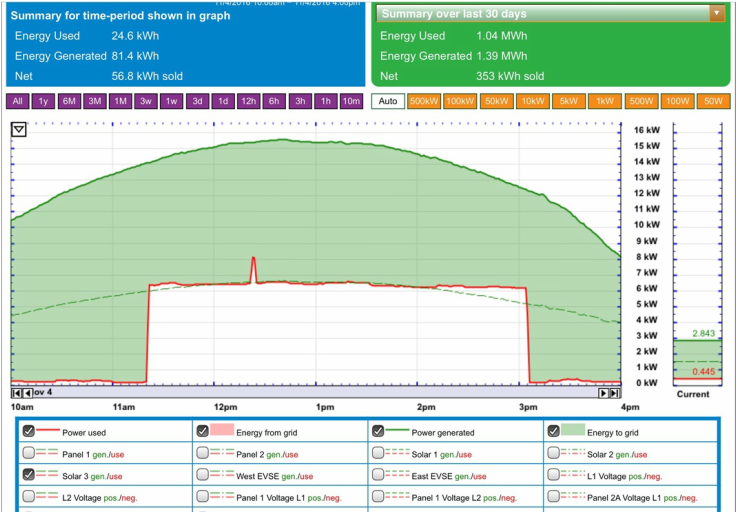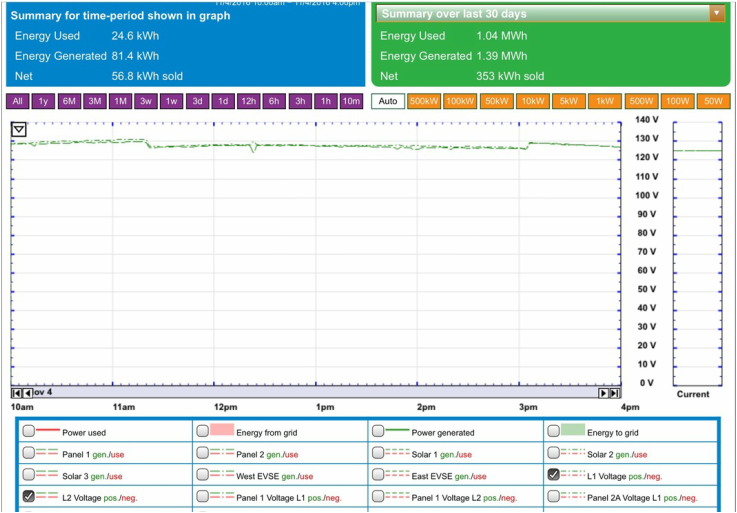|
Many loose ends have been wrapped up, although not all. One that has we have been struggling with for a few months now is one of our inverters cycling on sunny days (which is the last time you want an inverter not working properly). Below is an example of behavior we are seeing on our energy monitoring tool, eGauge: The dashed green line is the production from our solar inverter number 3. The solid green line is our overall production with three inverters, and the red line is our overall consumption. In the morning it was clear most of the morning. At about 11am, Inverter #3 shut down. You can see that the dashed line drops to zero. The other two inverters kept humming along normally. Typically when this happens the inverter would go through its automatic reset procedure which takes about 5 minutes. This isn't a problem for the inverters or for power generation as long as it doesn't happen often. On this day, it basically happened non stop, which creates a lot of wear and tear on the inverter and cuts into our power production rather dramatically. The guys from Innovative Power Systems have been great, they have come out many times to try to address the issue. We have seen some improvement after some updates to the inverter's firmware and some other inverter side configuration options. Rather than happening constantly, it only happens a half dozen times per day, on sunny days. They have also identified a red flag being the Voltage as measured creeps up over 260 Volts when the failure occurs. Immediately when the inverter goes down, the voltage also drops to 245-250V. Then, on November 3rd, something struck me after viewing that days eGauge... The solid green line is again production, the dashed green line power production from inverter #3, the red line power consumption (almost all of which is the car charging). While we had a few times between 10:30 and 11:30 where the inverter reset, and then again between 1pm and 2pm, there were none while I was charging! I took a look at the voltage: Sure enough, it appeared the voltage was peaking up above 260V, except when I was charging the car! (To measure the voltage we have to add the L2 and L1 voltage to get the total) To make sure, I took a closer look at the three failures in the afternoon. Here, I have zoomed in on just the 20 minutes or so covering the three afternoon inverter failures. I have also overlapped the graph of the solar inverter's production, overall production and voltage so it is easier to see them and how they relate. It isn't a big change in voltage, but it happens every single time there is a failure and is consistent until the inverter finishes its 5 minute reboot. While this isn't a fix, it gives me a way to try to minimize the issue. This was a beautiful sunny early November day. Not a cloud in the sky:) I waited until a bit after 11am and started charging my car. It continued charging throughout the peak hours and had the following affect on the voltage: This worked perfectly! The inverter behaved the entire day without so much as a hiccup.
And my car charged up fully on solar power:) Unfortunately, I don't need to charge my car every day, so I am looking for other ways to increase the load. Today I tried running a load of laundry at 10:30 as we were reaching peak power (earlier due to daylight savings time). Unfortunately that wasn't a consistent enough, or big enough load. As everything that could be tried on the inverter/configuration side has been tried has been, Innovative Power Systems is working on re-wiring the failing inverted with larger gauge wire. This won't happen for a few weeks though, so in the meantime I will do my best to find other temporary solutions. Right now though, I must go create, guide and revel my own civilization in just one more turn of Civilization VI (which I just downloaded yesterday).
Geoff Kuchera
11/7/2016 10:42:37 am
Do you have a graph that shows the power load going out to the grid? I'm wondering if the grid demand is overpowering the inverter. Not knowing how anything is actually connected..
Mark
11/7/2016 06:15:55 pm
The green shaded area would be the power going back to the grid. Comments are closed.
|
AuthorMark really doesn't like to talk about himself, the house is much more interesting. Archives
September 2020
Categories
All
|
